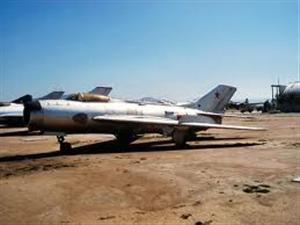Shenyang J-6
In early 1958 the Shenyang factory started gearing up to build the MiG-19P. This version, called Shenyang J-6, had an RP-5 lzumrood-2 radar (the same model as fitted to late-production MiG-17PFs) with a detection range of 12 km (7.46 miles) and was armed with two 30-mm (1.18 calibre) NR-30 cannons in the wing roots. The inter¬ceptor initially received the local designation Dongfeng-103 or Type 59A but was redesig¬nated Jianjiji-6 Jia, aka Shenyang J-6A, in 1964.
Five MiG-19Ps were delivered as CKD kits in March 1958 for starting production. Assembly of these kits began straightaway but took some time; the first MiG-19P assembled at Shenyang made its maiden flight on 17th December 1958 at the hands of Wang Youhuai. In April 1959 it was certificated by the State Certification Commission.
However, back in May 1958 Mao Zedong’s government had launched the notorious plan of accelerated industrial development called the ‘Great Leap Forward’. As mentioned earli¬er, the plan backfired dismally and the indus¬try was effectively disorganised. Also, at first the Chinese authorities decided they could set up Shenyang J-6 production without Soviet help and ordered the tooling to be manufactured local¬ly. This turned out to be a big mistake.
Full-scale production began in April 1959. However, trying to crank out as many fighters as possible, the factory let quality standards slip. The same held true for early-production WP-6 turbojets – this engine turned out to be far more complicated to build than the WP-5 previously produced by Liming; only in late 1960 did the quality improve perceptibly
As a result, most of the aircraft completed in 1959 and 1960 were deemed substandard and not accepted by the PLAAF. Eventually production had to be halted, all the jigs were thrown away and new ones made – with Soviet assistance this time.
 The Shenyang factory resumed production in 1961 with new jigs. Unlike the aircraft built in 1958-60, which were armed with NR-30s, the ‘new-production’ Shenyang J-6As had Type 23-2 cannons (a Chinese derivative of the NR-23) – just as had been the case with the baseline Shenyang J-6.
The Shenyang factory resumed production in 1961 with new jigs. Unlike the aircraft built in 1958-60, which were armed with NR-30s, the ‘new-production’ Shenyang J-6As had Type 23-2 cannons (a Chinese derivative of the NR-23) – just as had been the case with the baseline Shenyang J-6.
However, the interceptor turned out to be a bit too complicated to build for this plant and production was transferred to the smaller fac¬tory in Nanchang in Jiangxi Province which was trying to transition from propeller-driven aircraft to jets. Yet this factory too, managed to complete only seven J-6As in two years.
Despite the designation with no suffix letter, the radar-less Shenyang J-6 day fighter (initially called Dongfeng-103 or Type 59) actually appeared later than the J-6A. The J-6 was roughly equiv¬alent to the Soviet MiG-19S Farmer-C (to be precise, the late-production version with a slightly longer fin fillet), but they were not identical twins. Outwardly the Chinese version differed from the Soviet original in having the pylons (used for carrying unguided rocket pods) mounted at the wing leading edge rather than aft of the mainwheel wells, an emergency pitot head located to starboard rather than to port and only two cooling air scoops under each all-movable tailplane instead of four.
The first J-6 took to the air on 30th September 1959 with test pilot Wu Keming at the controls. However, the day fighter version initially suffered from the same quality prob¬lems as the interceptor, and the result was the same. By the end of 1960 production had ground to a halt and the Shenyang facto¬ry airfield was choked with J-6s and J-6As undeliverable due to poor manufacturing quality.
Production of entirely Chinese-built J-6s meeting the quality standards finally beqan in December 1963, though some sources claim the first ‘new-production’ J-6 flew on 23rd September 1963. Again, most of these ‘new- production’ J-6s were armed with Type 23-2 long-barrelled cannons; some had the short- barrelled version of the same weapon. A few retained the Type 30-1 (NR-30) cannons, albeit in modified form with large muzzle brakes. Finally some of the avionics and flight instru¬ments were different (Chinese derivatives of the original Soviet ones).
Export Shenyang J-6s bore the designation F-6, while the WP-6 engines were designated TJ-6 for export.
Production was mostly in batches of 40 air¬craft, though some batches are known to con¬tain up to 60. There were two construction number systems. One is straightforward – e.g., #6-6631 (that is, J-6, batch 66, 31st aircraft in batch); the # represents a hieroglyph standing for Jianjiji. The other system is a little more complicated – e.g., 47-1825; the first two dig¬its are an in-house product code or a code denoting the factory. The second system appears to apply to export aircraft and has been noted on some F-6s delivered to Pakistan.
The design bureau of the Shenyang factory soon set about making modifications to the basic Shenyang J-6. The brake parachute was relocated from its ventral compartment to a prominent bullet-shaped fairing at the base of the fin (thus the space below the rudder was put to good use at last). The reason for this modifica¬tion was that the original brake parachute caused the aircraft to pitch down sharply. This meant it could only be deployed safely when the nose-wheel was firmly on the ground. Conversely, a parachute located above the thrust line caused the fighter to pitch up, increasing drag; hence it could be deployed immediately after touchdown, reducing the landing run dramatically.
Less obvious changes were made to the flaps and airbrakes to increase their efficiency. The standard WP-6 engines gave place to WP-6AS – a locally-developed version of the RD-9BF-811 rated at 3,000 kgp (6,614 lbst) dry and 3,752 kgp (8,267 lbst) reheat. New hydraulic systems were installed and more powerful control surface actuators fitted.
